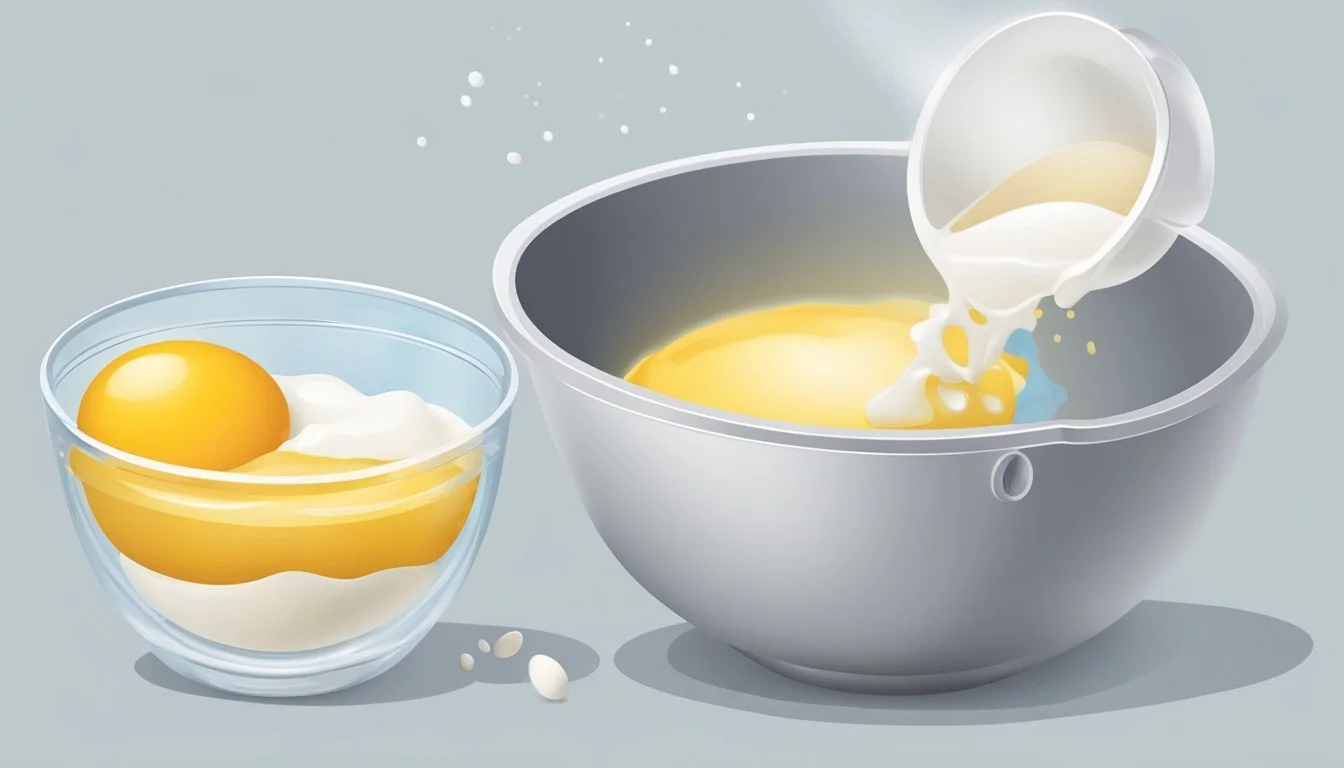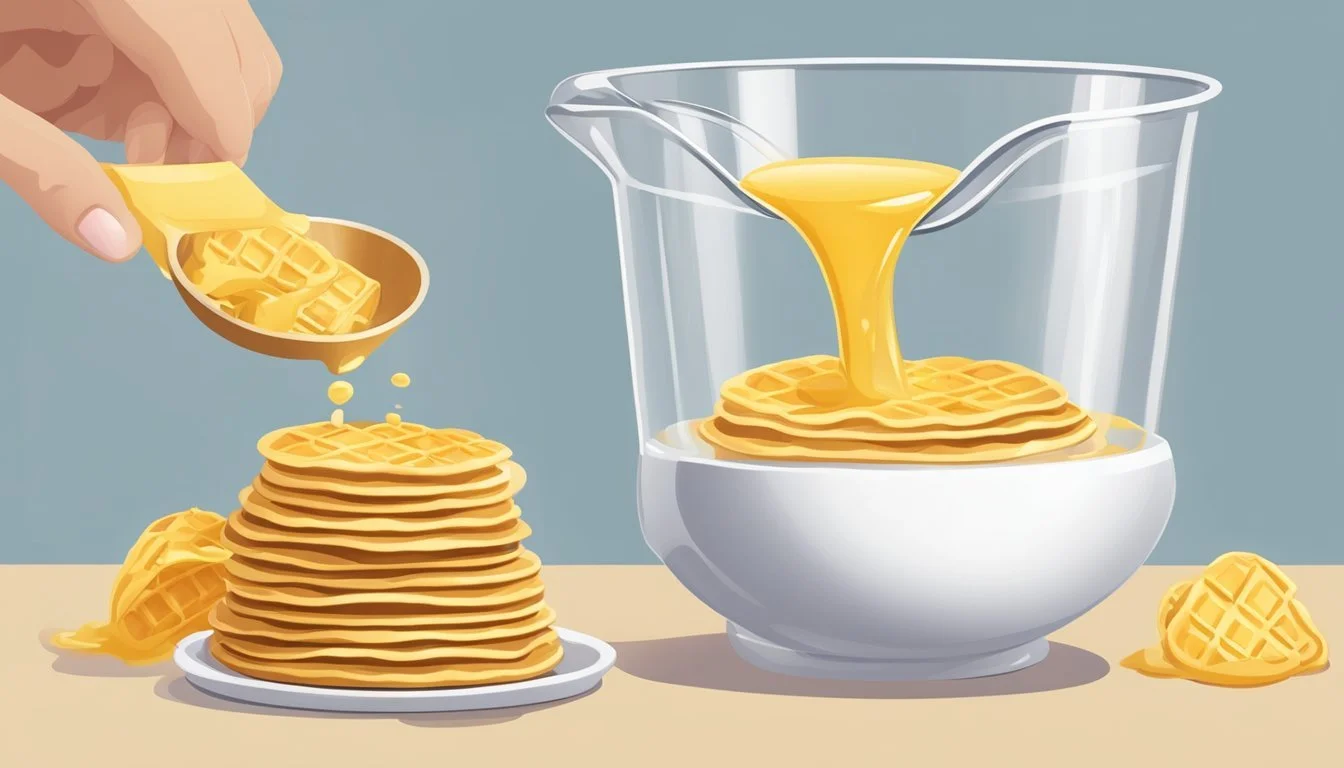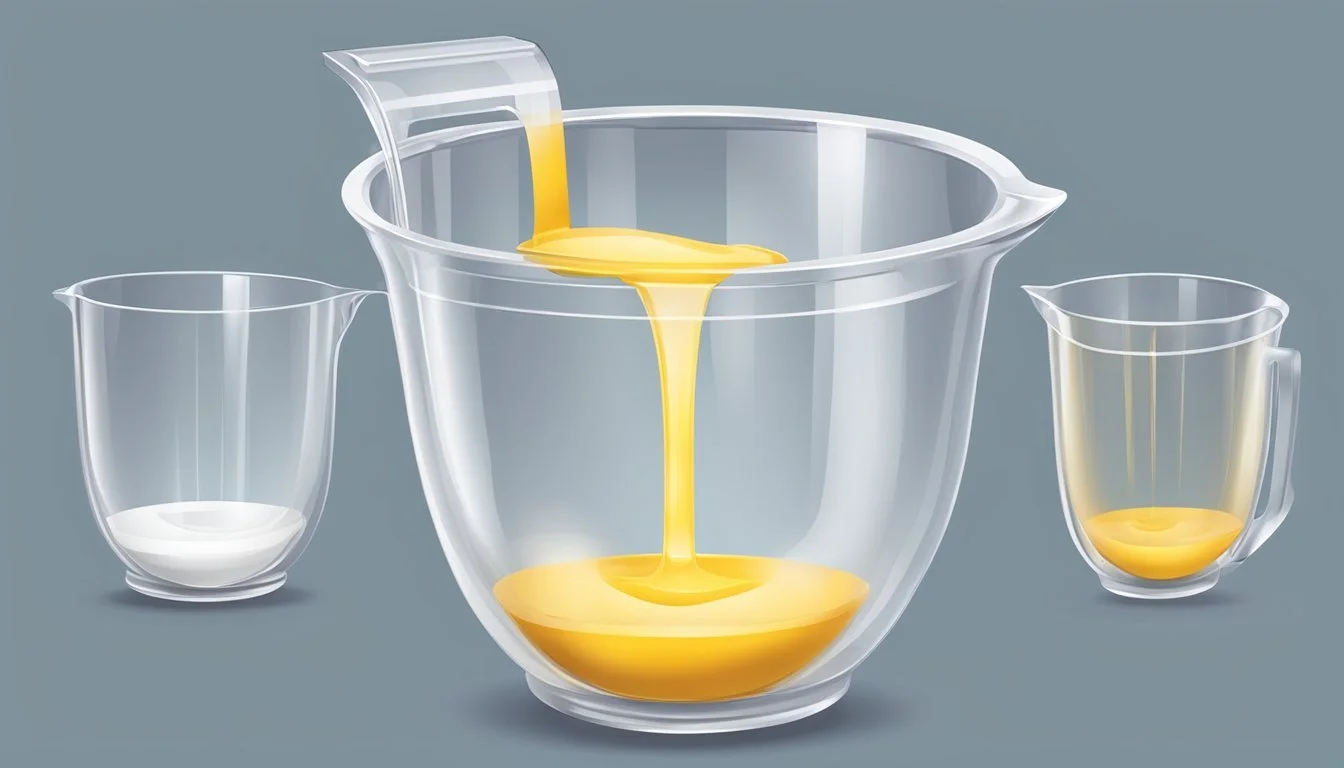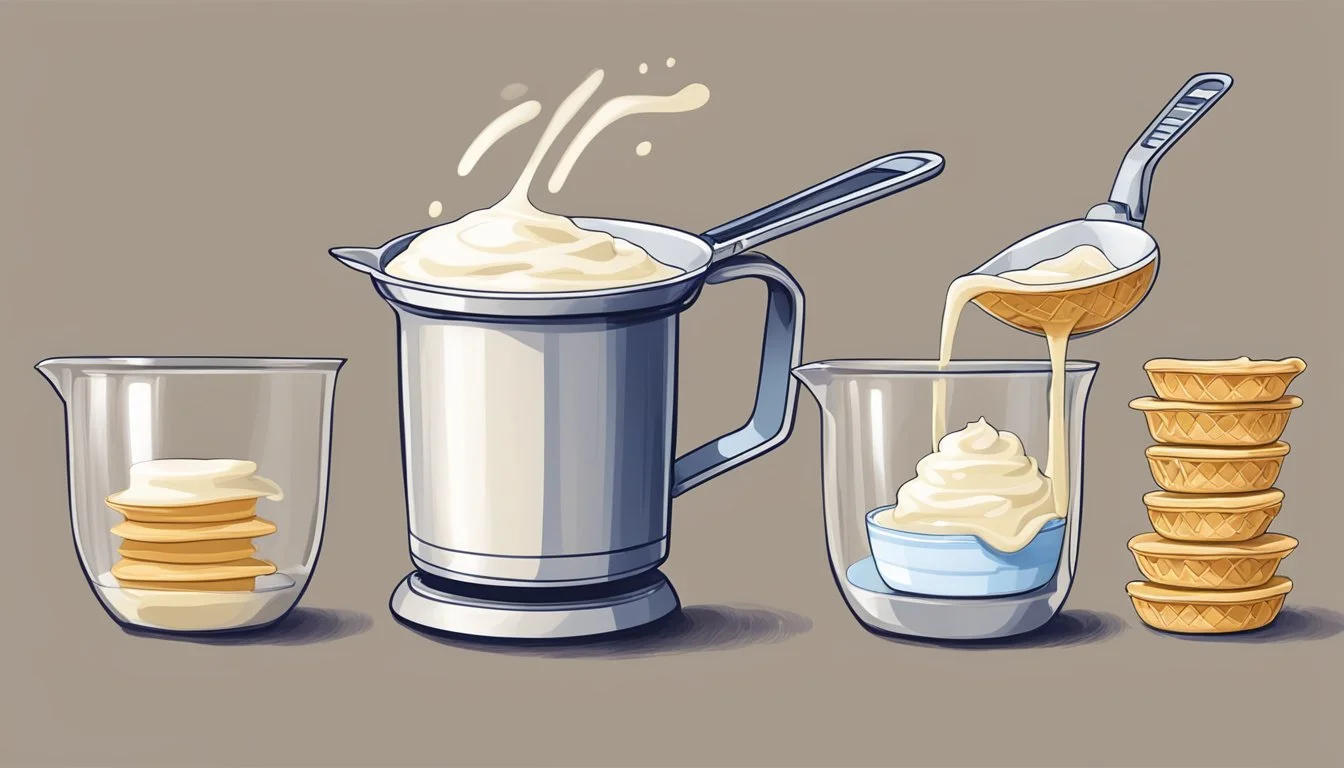How to Measure the Perfect Amount of Liquid for Waffle Batter
Precision Pouring Tips
Creating the perfect waffles begins with achieving the ideal consistency of waffle batter, which is contingent upon measuring the right amount of liquid. Utilizing the correct ratio of wet to dry ingredients is crucial in waffle preparation; too much liquid will cause the batter to spread out thinly, potentially resulting in soggy waffles, whereas too little may produce waffles that are too dry or dense.
One of the keys to perfect waffles is a batter of the right thickness, which allows it to spread evenly when poured onto the waffle iron but still maintain its structure to rise properly. The type of liquid, whether it be milk, buttermilk, or a milk alternative, not only contributes to the batter's consistency but also adds to the flavor and texture of the finished waffle.
Understanding the capacity and specifications of one's waffle maker is essential when determining the amount of liquid to use. Specific models may require different quantities to achieve the desired browning and crispiness. Careful measuring and adjusting of liquid components ensure that each waffle cooks evenly and comes out golden and crisp on the outside while remaining light and fluffy on the inside.
Understanding Waffle Batter Basics
Waffle batter is a crucial element in creating the perfect waffle, consisting of a balance between dry and wet ingredients. Dry ingredients typically include all-purpose flour, sugar, salt, and a leavening agent such as baking powder or baking soda to provide a fluffy texture.
Wet ingredients often feature milk, eggs, and a fat component like oil or melted butter. The correct ratio of these ingredients is essential for batter consistency.
Key Ingredients and Their Roles:
Flour: Serves as the structure, with all-purpose flour being the standard choice.
Milk: Adds moisture and affects the batter's liquidity.
Eggs: Provide stability and richness to the batter.
Sugar: Granulated sugar adds sweetness and helps in browning.
Salt: Enhances flavor and balances sweetness.
Baking Powder: A common leavening agent that aids in rising.
Oil/Butter: Contributes to the taste and crispness on the exterior.
Batter Consistency:
The consistency of waffle batter should be thick yet pourable, similar to a cake batter. If the batter is too runny, it will not hold its shape in the waffle iron. Conversely, a batter that is excessively thick can result in waffles that are dense and chewy rather than light and fluffy. Adjusting the amount of milk or flour can help achieve the desired consistency.
Combining Ingredients:
When combining ingredients, one should first mix the dry ones, then carefully blend in the wet ingredients until just combined, taking care not to overmix as this can lead to tough waffles. Achieving a smooth, homogenous batter without overmixing is a delicate balance that results in the perfect texture.
Measuring Ingredients Accurately
Accurate measurements are paramount in achieving the perfect consistency and flavor in waffle batter. Using the right tools and techniques ensures the batter has the correct texture for ideal waffles.
Dry Ingredients
To measure dry ingredients such as all-purpose flour and sugar for a waffle recipe, one should use measuring cups specifically designed for dry components. A general rule is to lightly spoon the ingredient into the correct measuring cup and level it off with a straight edge. For most waffle recipes, the quantity of flour is crucial; too much can produce a dense waffle, while too little may lead to overly light and fragile waffles.
Ingredient Measurement All-purpose flour 1 cup (spooned and leveled) Granulated sugar 1/2 cup (spooned and leveled)
Liquid Components
Liquid ingredients, including milk and water, must be measured in liquid measuring cups to ensure the amount of batter is accurate. These measuring cups are usually clear with measurement lines on the side, allowing the cook to pour the liquid in and check the amount at eye level. To create the perfect waffle batter, one must pour the liquid until it reaches the desired measurement marking, ensuring the cup is on a flat surface.
Milk: Pour until the desired line is reached without going over.
Water: Same method as milk, ensuring a steady hand.
Eggs and Additives
Eggs are a key component in waffle recipes; they should be fresh and usually at room temperature. Often, a recipe may call for the egg to be separated, with the white beaten to a stiff peak before folding into the batter. As for additives like vanilla extract or melted butter (sometimes referred to as a stick of butter in recipes), measuring spoons should be used. When a recipe specifies tablespoons or teaspoons, one should fill the spoon with the additive until it's full and level off the excess.
Additives (such as vanilla extract) Measurement Vanilla extract 2 teaspoons (levelled) Melted butter 1 stick or 1/2 cup (measured then melted)
By meticulously measuring each component of the batter, the waffle enthusiast is well on their way to creating the perfect waffles with a desirable balance of flavor and texture.
Mixing Techniques
In preparing waffle batter, the method of mixing can make or break the end product. One should focus on achieving the ideal consistency while being vigilant to avoid common mistakes during the process.
Achieving the Right Consistency
The goal for waffle batter consistency is a smooth, flowing mixture that is thick enough to hold its shape but thin enough to spread easily in the waffle iron. A batter that's too thin will yield limp, undercooked waffles, whereas a mixture that's too thick will be difficult to spread, leading to uneven cooking. One can use this visual and tactical guide:
Perfect Consistency: The batter should fall off the spoon in a steady stream and form a slight ribbon on the surface before sinking back in.
Thickness Check: A good thumb rule is that the batter should be similar to a slightly thickened pancake batter.
To test if you’ve got the right consistency, pour a scoop onto the hot waffle iron. The batter should spread toward the edges, leaving just a small margin, and start cooking immediately without running off the sides.
Avoiding Common Mixing Mistakes
When combining the ingredients, one should aim to mix just until the dry and wet components are blended together. Overmixing the batter activates the gluten in the flour, leading to tougher waffles. Here are key points to remember:
Do Not Overmix: Mix the batter gently until you no longer see streaks of flour. It's okay if there are a few small lumps.
Rest the batter: If the waffle mix is slightly lumpy, letting it rest for a few minutes allows the lumps to hydrate and dissolve.
Use correct tools: Employ a folding motion with a spatula rather than a whisk to combine ingredients. This will prevent overworking the mixture.
In handling thick batter, if the consistency is too heavy, it may be cautiously thinned out with a small amount of liquid, such as milk or water, but this should be done sparingly to maintain the structural integrity of the waffles.
Preheating and Greasing the Waffle Iron
Achieving the perfect waffle begins long before the batter is poured. It starts with properly preheating and greasing the waffle iron, which are critical steps to ensure consistent cooking and easy waffle release.
Importance of Preheating
Preheating the waffle iron is essential to achieve an even and thorough cook. Manufacturers typically recommend allowing the appliance to heat for a few minutes until it reaches the desired temperature. Most waffle irons have an indicator light that signals when preheating is complete. This process ensures that the batter starts cooking immediately upon contact, which contributes to a well-defined, crisp exterior.
Heat: Sufficient preheat time.
Preheat: Follow the manufacturer’s instructions.
Waffle iron: Check for an indicator light.
Using the Right Amount of Grease
A non-stick surface is key for a smooth waffle release. For waffle makers, especially Belgian waffle irons, it's important to use the right amount of grease. Cooking spray or non-stick spray is typically recommended due to its ease of application and effectiveness. Apply a thin, even layer to coat the surface; over-greasing can lead to soggy waffles and under-greasing to sticking.
Non-stick: Apply a thin, even layer of grease.
Waffle maker: Suitable for both standard and Belgian waffle irons.
Cooking spray: Use a light coating, as per the manufacturer’s instructions.
By adhering to these guidelines, bakers can lay the foundation for perfect waffles every time.
Pouring the Perfect Amount of Batter
Achieving the ideal waffle requires precise batter quantity and careful pouring technique to prevent overfilling. These steps ensure that each waffle is uniformly cooked with a consistent texture and shape.
Gauging the Quantity
For a standard 7-inch waffle iron, the ideal amount of batter typically ranges from 1/2 to 2/3 cup. When using a larger Belgian waffle maker, the quantity increases to about 3/4 cup. The key is to pour just enough batter to fill the grids without causing excess to spill over the edges. One should pour the batter into the center of the waffle iron and then gently spread it towards the edges if necessary. This central pouring technique helps the batter to naturally flow and achieve an even distribution.
Preventing Overfilling and Spills
Overfilling the waffle iron can create mess and affect cooking times. It can also be wasteful and might potentially harm the waffle maker. To prevent spills, it's essential to:
Start by pouring in the center and allow the batter to spread to the edges.
Close the lid gently to avoid displacing the batter.
Monitor the fill level, especially if it's the first time using a new waffle maker.
As consistency leads to perfection with waffle-making, carefully following these guidelines each time can help in preventing overfilling and the need for unnecessary clean-up after cooking.
Cooking Time and Techniques
Achieving the perfect waffle is as much about the timing and technique used during cooking as it is about the batter consistency and ingredients. Expertise in using the waffle iron, along with careful monitoring, can make the difference between good and great waffles.
Timing for Optimal Cooking
For optimal cooking, one should adhere to the waffle maker's instructions, as each model has its specific guidelines. However, a general rule is that waffles typically take between 3 to 5 minutes to cook. Every waffle iron, be it the Cuisinart WAF-F20 Double Belgian Waffle Iron or the Bella Classic Rotating Non-Stick Belgian Waffle Maker, has a ready indicator light or beep to signal when it's time to add the batter and when the waffle is cooked. To ensure consistency across multiple batches, one should use a timer. Additionally, maintaining a stable heat setting prevents the waffles from cooking unevenly.
Monitoring for Even Cooking
Monitoring the waffle during cooking is crucial for even cooking. It is important to spread the batter evenly across the surface of the iron to avoid thin or undercooked areas. One should resist the urge to open the waffle maker too early, as this can lead to splitting and uneven cooking. The steam release is a natural part of the cooking process, and when it begins to slow down, it usually indicates the waffle is nearly done. Some waffle makers, like the Bella Classic Rotating Non-Stick Belgian Waffle Maker, benefit from a rotation feature that ensures even batter distribution and consistent browning on both sides.
Waffle Toppings and Accompaniments
The right toppings can transform waffles from a simple breakfast to a memorable meal. They should complement the waffle's flavor and add contrasting textures. Below are specific toppings that can suit any preference, from sweet to savory.
Sweet Toppings
Maple Syrup: A classic drizzle that's essential for its smooth, sweet flavor.
Whipped Cream: Adds a light, airy texture and a creamy taste.
Fresh Fruit: Slices of strawberries, bananas, or a berry mix for a refreshing, tangy twist.
Nuts: Chopped pecans or walnuts offer a satisfying crunch and nuttiness.
Jam: A spread of rich fruit preserves can balance sweetness with acidity.
Chocolate Sauce: For a decadent, rich addition.
Honey: A natural sweetener that provides a sticky, sweet flavor.
Nutella: A spread of hazelnut chocolate offers a luxurious, creamy texture.
Topping Description Note Maple Syrup Smooth and sweet, perfect for soaking. Use pure maple syrup for the best flavor. Whipped Cream Light and airy, provides a creamy contrast. Can be sweetened or flavored. Fresh Fruit Tangy and refreshing, bring natural sweetness. Use seasonal fruits for better taste. Nuts Crunchy and nutty, adds texture. Toast lightly to amplify flavor. Jam Fruit preserves give sweetness with acidity. Choose a variety with chunks for extra texture. Chocolate Sauce Decadent and rich chocolate flavor. A little goes a long way. Honey Sticky sweetness, a natural flavor. Local honey provides unique regional tastes. Nutella Creamy hazelnut chocolate spread. Combine with bananas for a classic pairing.
Savory Additions
Fried Chicken: A southern staple that pairs crispy, salty chicken with the waffle's fluffy sweetness.
Bacon: Crisp bacon strips can add a savory, smoky flavor.
Cheese: Shredded or sliced cheese melted over waffles can create a delicious salty contrast.
Herbs: Fresh herbs like thyme or rosemary can infuse waffles with aromatic flavors.
Addition Description Note Fried Chicken Salty and crispy, balances sweet waffle flavors. Best served hot and with a side of syrup. Bacon Smoky and savory, a classic breakfast component. Cook until crispy for the best texture. Cheese Melty and salty, offers a rich flavor contrast. Use strong-flavored cheeses for more impact. Herbs Aromatic and fresh, subtly enhances taste. Chop finely and sprinkle over the top.
When choosing waffle toppings and accompaniments, consider how flavors and textures will work together. The goal is to create a harmonious blend that elevates the humble waffle to culinary delight.
Post-Cooking Care and Storage
After cooking the perfect waffles, proper care for the waffle maker ensures its longevity and consistently good performance. Correct storage of leftover batter can save time and maintain the quality for future use.
Maintaining a Clean Waffle Maker
One must let the waffle iron cool completely before attempting any cleaning to prevent burns and damage to the appliance. For non-stick waffle makers, gently wipe away any leftover batter with a soft cloth or paper towel. If batter is sticking, a rubber spatula can help loosen any remnants. For a thorough cleaning, dampen a cloth with warm, soapy water and clean the grids. Ensure the iron is dry before storing to prevent rust and corrosion.
Storing Leftover Batter
Leftover batter should be stored properly to avoid spoilage. Transfer the batter to an airtight container and keep it refrigerated. Here's a brief guide for storage duration:
Refrigeration Time Expectancy Up to 2 Days Optimal Use 3-4 Days Acceptable Quality
Use the batter within 2 days for best results, but it may still be usable up to 4 days. Before reusing, stir the batter to redistribute ingredients that may have settled. Do not freeze the batter as it can affect the texture and leavening ability upon thawing.
Troubleshooting Common Waffle Issues
When crafting the perfect waffle, one must pay attention to batter consistency and cooking technique. Even small deviations can lead to less than ideal results. Here's how to tackle common challenges faced during the waffle-making process.
Batter Problems
Incorrect Consistency: Waffle batter should coat the back of a spoon but still be pourable. If the batter is too thin, it may result in soggy waffles; if too thick, waffles can become dense. To remedy this, adjust the liquid amounts accordingly, aiming for a balance between milk (or water) and the dry ingredients.
Too much liquid: Reduce the amount incrementally to avoid overly soft waffles.
Too little liquid: Add liquid in small amounts until the desired consistency is achieved.
Gluten Formation: Overmixing the batter can create excess gluten, leading to tough waffles. Mix until just combined to maintain a light and fluffy texture.
Cooking Challenges
Waffle Sticking: A preheated and well-greased waffle iron is essential to prevent sticking. Use a brush or paper towel to apply oil evenly before adding batter.
Prevent sticking: Apply a thin layer of oil to the iron's surface before each waffle.
Inconsistent Rising: For waffles to rise evenly, ensure a consistent heat level and avoid peeking during the cooking process, which can release steam and heat.
Avoid opening: Only open the waffle iron once the cooking time has completed to prevent deflation.
Troubleshooting Tips:
Make sure the waffle iron is hot enough before adding batter.
Use a timer to prevent over- or under-cooking.
Follow the waffle iron's manual for the correct amount of batter.
Look for visual cues like steam ceasing to indicate doneness.
By addressing these specific batter and cooking issues, one can pave the way for waffle perfection.
Advanced Waffle Making Tips
In pursuit of the perfect waffle, one can explore various ingredients to enhance flavors and textures while also leveraging specialized equipment for improved results.
Experimenting with Flavors and Textures
To create exceptional waffles, an individual might incorporate a dash of cinnamon or freshly grated nutmeg for a warm spice. It is recommended to fold whipped egg whites into the batter to achieve a light and airy texture, especially in Belgian waffles. Here is an example of how to adjust a basic waffle recipe:
Butter: Use unsalted butter for a rich, luscious flavor.
Vanilla: A teaspoon of pure vanilla extract can elevate the batter.
Cinnamon and Nutmeg: Start with a ¼ teaspoon of each and adjust to taste.
Egg Whites: Separating the eggs and whipping the whites before adding them to the batter can significantly lighten the texture.
Expert-Level Equipment Insights
A high-quality Belgian waffle maker contributes to achieving the coveted crisp on the outside and soft on the inside. An individual seeking versatility might consider a 3-in-1 waffle maker for diverse shapes and sizes. For the best overall performance, even heating and adjustable temperature control are key features. Meanwhile, for best value, one must balance cost with the desired features in their waffle maker. Some expert tips include:
Preheating the waffle iron is essential for consistent cooking.
Irons with non-stick surfaces should not require non-stick spray when used properly.
A measuring cup can aid in pouring just the right amount of batter to prevent overflow.
By applying this specialized knowledge, one can craft waffles that are not only delicious but also visually appealing and texturally satisfying.
Frequently Asked Questions
How much batter is ideal for a standard waffle iron?
For a standard 7-inch waffle maker, one should aim to use roughly 1/2 to 2/3 cup of batter. This ensures that the waffle is fully formed without overflowing.
What is the best way to pour batter into a waffle iron?
Ideally, one should use a ladle or a measuring cup to pour the batter into the center of the preheated waffle iron. This helps in spreading the batter evenly and controls the quantity.
Can the batter amount vary based on the waffle maker size? Yes, the amount of batter needed changes with the size of the waffle maker. Users should refer to their waffle maker's manual for specific measurements.
What is the secret to achieving perfect waffle batter consistency?
One should whisk the mixture until smooth, ensuring that there are no lumps. The consistency should be similar to a thick pancake batter.
Does the waffle iron type affect the batter amount?
Waffle irons can be either Belgian or standard, and each type may require different batter amounts due to depth differences. For Belgian waffle makers, a larger amount may be necessary.
How can someone master their breakfast game with waffles?
By precisely measuring and consistently practicing, anyone can improve their breakfast preparations. Ensuring the right batter amount and properly preheating the waffle iron are key steps.










